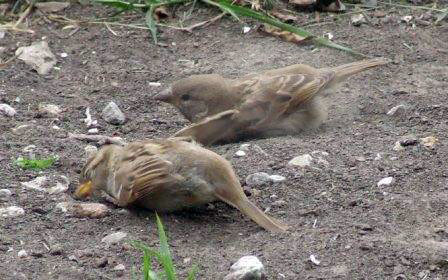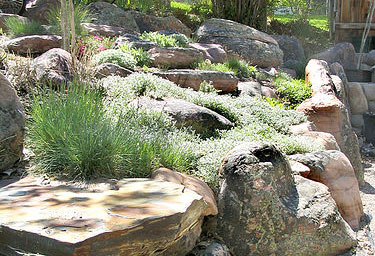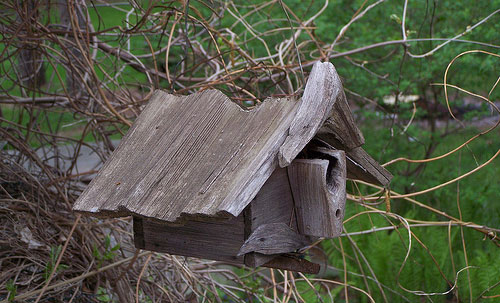Attracting Birds & Butterflies

Even as interest in butterly- and bird-watching grows every year, along with our knowledge of behavior and ecology, the habitat available to birds and butterflies is shrinking, along with their numbers. This is largely due to new development, although global warming now seems to be a factor also. One of the best things we can do help the birds and butterflies, and at the same time fulfill our interest in seeing more of them in our backyard is to provide them with more habitat. We can do this through selective planting of trees, shrubs, perennials, and annuals which are favorable to their diet and lifestyle.
Birds and butterflies use plants in several ways: for shelter, for nesting/overwintering, and for food. Many birds also have specific nitche: either feeding on the ground, in the understory, or in the upper canopy. Birds also have specific nesting preferences, with some birds perfering to nest up high, others low, some in thinckets, some in trees. For this reason, the bird garden will attempt to create a multi-level canopy of trees and shrubs, intersperced with open areas and native flower gardens, with as much variety of bird & butterfly-friendly plants as possible. The majority of plants will be native species, as this is what the birds are accustomed to eating and using, and the specific plants chosen will depend on the growing conditions in your yard. Some evergreen shrubs and trees should be included for winter shelter, and there are a number of annual and perennial flowers which provide edible seeds and nectar. A number of butterfly species also have specific host plants that they will lay eggs on, and where the caterpillars will spin their cacoons the following spring and summer.
Many plant lists are available on the web. Here is our list of favorite plants for attracting birds and butterflies.
Hedges & Thickets

Hedges and thickets - rows or clusters of dense shrubs - are an important addition to the bird garden. They provide a safe place for birds to rest and to nest, and also provide an important source of fruit and insects, which are used as food. Besides being good for the birds, hedges and thickets can act as wind breaks, provide privacy from neighbors, and block undesirable views.
Lawn, Groundcover, & Leaflitter

Small areas of lawn can be good for viewing ground-foraging birds, and can provide some food source. Groundcovers can provide a better food source, though, and require less maintenance. Short groundcovers that bear fruit are best for attracting birds. Examples include: bearberry, bunchberry, cotoneaster, creeping juniper, green & gold, creeping dogwood, creeping st. johnswort, partridgeberry, & barren strawberry. Leaflitter (fallen leaves) is also a great source of worms and insects. It can often be left unraked under shrubs and trees without being very noticible.
Water

Birds and butterflies need to drink too! Especially in the hot summer. And many birds love to take baths. A small pond is a great way of attracting birds, but even a birdbath will bring an amazing number of birds. Some birds (especially warblers) are attracted by the sound of dripping water, so a dripper can be attached to the bird bath. If you build a pond, be sure to create areas for the birds to wade - either a gently sloping pebble beech or a slowly flowing shallow stream - and maybe a few rocks to perch on. This is where you will see the birds taking a bath.
A number of water plants are attractive to birds and can be included in your pond design. They will also protect the frogs, fish, insects, and fish in the pond. If you are interested in attracting herons and kingfishers, stock your pond with small fish. But don't become too attached to them, because the birds will definately come! If you want to protect your fish, you can build sheltered areas for them to hide.
Dust Baths

Some birds perfer to bathe in the dust, which is thought to help with parasites and feather maintenance. A dust bath should be about 3 feet wide and long - big enough for the birds to flop around in. A good soil mix for the bath is equal parts of sand, loam, and ashes.
Slopes

Some ground-foraging birds are especially drawn to uneven sloping ground, such as a small hill with outcropping rocks, logs, and low plants. A rock wall or rock garden is ideal for this purpose. Many groundcovers work well also.
Feeders

Providing additional food will definately increase the number of birds visiting your yard. In the winter and early spring, bird feed will help birds replenish their reserve of fats and carbohydrates. Beef suet (fat - available at any meat counter) is an excellent winter food. Consumed by most birds, the fat takes the place of insects in their diet, and can be mixed with cornmeal or peanut butter for more variety. Raisins, grapes, and cherries are also greatly appreciated by robins, mockingbirds, and waxwings. In the fall, providing oil-rich niger and sunflower seeds will attract migrating birds like the white-throated sparrow and rufous-sided towhee. In the summer, food is most plentiful, but birds still fly the extra distance to sample some overripe fruit left on a perch (butterflies like these too), or eat a bird-cookie (one part vegetable shortning, 1 part peanut butter, 1 part flour, 4 parts cornmeal - don't bake!)

Bird Houses

Providing a pair of birds with a house is a great way to get to know them more intimately. You will get to see them every day and watch as their fledglings hatch and grow. Different birds have slightly different requirements, so decided which types of birds you want to attract, and research their needs. A specific hole size will allow certain birds while detering others, and some birds require a minimum amount of living space. Also, don't forget about owl and bat boxes! They are both desirable species (bats will devour insects and mosquitoes and owls will generally fly elsewhere to hunt).
Pest Control Strategy
Most synthetic pesticides are not bird or butterfly friendly. Remember that butterflies are insects too, and will be killed by pesticides. Birds will eat insects exposed to pesticides and suffer as a result. Creating a bird-friendly habitat takes a somewhat diffent outlook on pest management. Remember that one of the best ways to attract birds is by providing insects as a food source. Insects thrive on plants and especially flowers, and birds will thrive on the insects. Most insects will cause only minor damage to landscape plants, and in fact, most insects are beneficial to the garden (read the article). By creating a diverse garden with many beneficial insects and resistant plants, the serious plant pests will be seriously hampered, and not likely to cause much trouble. Still, it is a wise policy to monitor your plants closely for serious problems, and treat them as soon as possible when the conditions warent. Often there are non-toxic approaches that will resolve the problem. We can help you identify which plants may be at risk, tell you how much damage should be acceptable without compromising plant health, and identify a low-risk strategy for managing serious pests or disease when they do arise.Ferncreek Design & Build * Olivebridge, NY
12461
(845) 657 - 1905 * info@ferncreekDB.com
.
Serving most points within Ulster County including Samsonville,
Palentown, Krumville, Tabasco, Kerhonkson, Lyonsville, Stone Ridge,
High Falls, Alligerville, Accord, Cherrytown, Naopnach, Ellenville,
Rosendale, Tillson, Esopus, Mt Tremper, Phoenecia, Chichester, Willow,
Lake Hill, Shady, Bearsville, Woodstock, West Hurley, and Hurley. See
Service
Area Map to confirm service to your location.